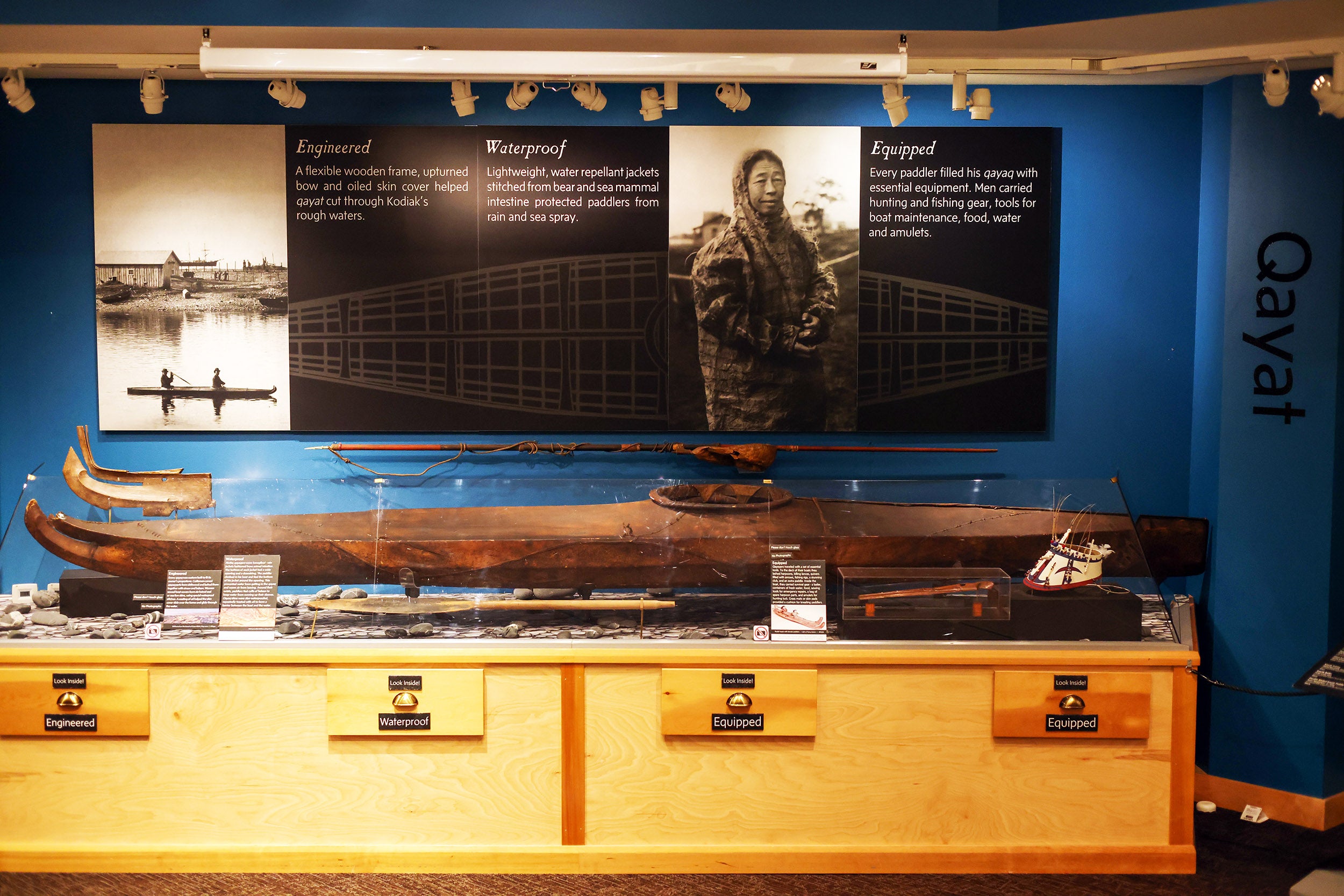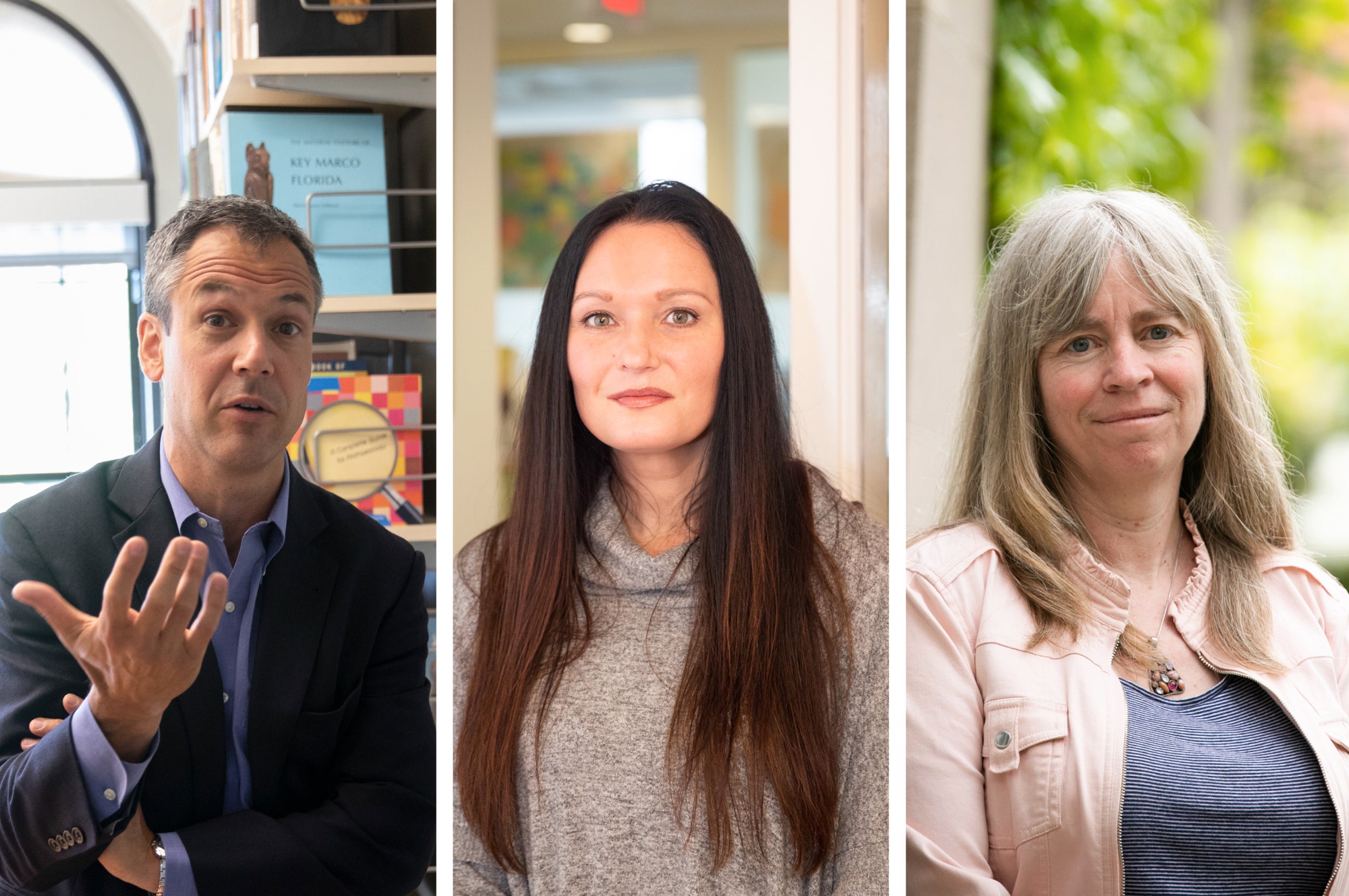
Historic kayak and other artifacts on display at the Alutiiq Museum, where Harvard’s Peabody Museum of Archaeology and Ethnology recently transferred legal ownership.
Photo courtesy of the Alutiiq Museum
Peabody Museum charts progress on repatriation
NAGPRA project staff doubled to support three-year commitment for consultation, return of all ancestors and associated funerary belongings
In 1990, the U.S. Congress enacted the Native American Graves Protection and Repatriation Act (NAGPRA) to guide the work of repatriating Native American human remains, funerary objects, sacred objects, and other objects of cultural importance to lineal descendants, the tribes, and Native Hawaiian organizations.
Harvard’s Peabody Museum of Archaeology and Ethnology cares for most of the items at the University that fall under NAGPRA’s purview. A recent letter from U.S. senators and members of the Senate’s Committee on Indian Affairs requested an update on Harvard’s processes and pace of repatriation under NAGPRA. The Peabody responded with an in-depth description of the Museum’s policies and methods, including the assessment that strong support by the University’s administration and the doubling of NAGPRA-dedicated staff over the past year have greatly sped the Peabody’s rate of repatriation.
To gain a greater understanding of the Peabody’s progress and processes regarding NAGPRA, the Gazette recently sat down with Matthew Liebmann, chair of the Peabody’s Faculty Committee, Peabody Professor of American Archaeology and Ethnology, and chair of Harvard’s Department of Anthropology; Kelli Mosteller, executive director of the Harvard University Native American Program; and Jane Pickering, the William and Muriel Seabury Howells Director of the Peabody Museum.

Matthew Liebmann, Kelli Mosteller, and Jane Pickering.
Harvard file photos
Q&A
Matthew Liebmann, Kelli Mosteller, Jane Pickering
GAZETTE: Why is Harvard in such a unique position here?
LIEBMANN: The Peabody, as with Harvard University more generally, is the inheritor of the long legacy of American history and all that entails — including colonialism, dispossession, and enslavement. We have the weight of nearly 400 years on our shoulders. We are also the inheritors of collections amassed over that period and the privilege that went into the formation of these collections. It’s our ethical duty to address that heavy history. Repatriation is a fundamental part of that process.
MOSTELLER: It’s important to understand that the scale of Harvard’s involvement is different than many other institutions. There are thousands of ancestors in the collections, and they came to be there as a result of practices that were deeply disrespectful and damaging to Native communities. We are one of the worst offenders, and that’s why Harvard’s actions, and lack of action, have attracted attention and criticism, and why we will be watched closely in terms of what steps we take next.
PICKERING: When the University started this work in the 1990s, we were in touch with all 574 federally recognized tribes in the country. Our collecting practices had an impact on nearly every Tribal Nation, every community.
GAZETTE: Why is this work important?
MOSTELLER: Institutions with NAGPRA collections bear a profound responsibility to both the ancestors and to Native communities. We must acknowledge that real harm has been done. It is our duty to carry out each stage of this work with professionalism, but also deep empathy and unwavering compassion. When the NAGPRA-mandated portion of the work is done and the ancestors have been returned to their communities, that can’t be the end of our responsibility. That’s the beginning of the process for the people to whom these ancestors are being returned. There’s so much emotional, spiritual, and cultural labor still to be done. We have to be good allies and support those communities.
LIEBMANN: Properly done, repatriation can open new opportunities for all involved in the process. The Peabody’s 1999 repatriation of the ancestors from Pecos Pueblo to Jemez Pueblo in New Mexico started a process that made possible my work that continues with Jemez today. Jemez was interested in establishing a mutually beneficial relationship coming out of the experience that they had with the Peabody. Many communities aren’t interested in continuing their relationships with museums after a repatriation, and understandably so. But for those that are interested in developing or enhancing a relationship with Harvard, the repatriation process can serve as a door to bring people from outside Harvard to our campus, and to bring people from Harvard into the outside world.
GAZETTE: In 2021 President Larry Bacow apologized on behalf of the University for what he referred to as “practices that placed the academic enterprise above respect for the dead and human decency.” Do you feel that apology extends to what many have called the slow pace of this work on the part of Harvard?
PICKERING: At the time President Bacow made his apology, I apologized to Native communities specifically for the practices that led to the collections of ancestors at the museum and for missteps we had made in our implementation of NAGPRA. I think historically the Peabody did not always act proactively and center its work on the impact of the history on affected communities. We must acknowledge that NAGPRA is about much more than a series of transactions and a one-time apology. It is about fundamental change to the structure, practices, and values of the museum — what we describe as ethical stewardship, which includes conversations, engagement, and shared authority with Tribal Nations.
MOSTELLER: NAPGRA’s the floor, not the ceiling. It defines the bare minimum we have to do to be in compliance with the law, but we have a moral responsibility to do more, especially when we are genuinely engaging in consultation and we hear what communities need from us. We need to set their requests as our new standard.
GAZETTE: How have you improved your processes?
PICKERING: In the past year, we’ve more than doubled the size of our NAGPRA office, and we now have one of the largest staff devoted to NAGPRA in the nation. We also have new positions in other departments to provide the necessary support for NAGPRA activities. We added these significant resources as a foundation for our three-year commitment to support consultation and repatriation of all ancestors and their funerary belongings.
We have also invested additional resources to consult with Tribal Nations and lineal descendants regarding the return of a large collection of hair clippings. Anthropologist George Woodbury, a Harvard lecturer, amassed hair clippings from Indigenous people around the world, including, heartbreakingly, from approximately 700 Native American children and adults then at U.S. Indian boarding schools. Woodbury’s collection was donated to the Peabody in 1938. I have personally spoken with Tribal representatives and lineal descendants from across the country, which has involved many tough conversations but also the honor of learning about the relatives’ stories and experiences. We’ve been working really hard, and the clippings are already going home to lineal descendants and communities.
GAZETTE: What does this work look like going forward? What are you focused on in terms of where you want to make progress and what will community members see in the coming year and years?
MOSTELLER: Every conversation I’ve had with a Tribal community during my first year at Harvard, whether it is regarding a campus visit or encouraging students from their Tribal community to apply, the first question asked is, “What about all of our ancestors that you’ve had for decades upon decades?” They don’t want to talk about anything else until we talk about NAGPRA and the ancestors. This is the domino that has to fall before the deeper partnerships that we want to have with Tribal communities can happen. From the Tribal communities’ perspectives, why would they want to send their kids where their ancestors are being held or kept as collection items?
LIEBMANN: Also, the Peabody now has policies that go beyond NAGPRA. We are now able to do repatriations not only under the law, but for other objects, artifacts, materials, and ancestors not covered by NAGPRA that are currently stewarded by the Peabody. I think that’s an incredibly important change.
PICKERING: Under these new policies, we recently legally transferred a warrior-whaler kayak to the Alutiiq community. It is the culmination of a partnership that began with a NAGPRA consultation back in 2002. It involved a long-term project for the conservation of the kayak, together with the community, as well as visits, workshops, and an exhibition. In 2016 the kayak was physically transferred to the Alutiiq Museum in Kodiak, Alaska, but it was not owned by the community. Rather, it was still owned by us. In 2023 we transferred legal ownership to the Alutiiq Museum, which meant the kayak has truly gone home to be cared for by the community.
MOSTELLER: A part of true consultation is to legally transfer objects, even if the tribes are not in a position where they are ready to physically take possession. And that means listening to the tribe when they say that they do not have enough staff, they don’t have appropriate land for reburial, or they don’t have the resources to physically transfer at this time. It is still vitally important for this legal transfer to happen. It’s critical to always come back to the tribe to ask: Where are you in your process? How can we help? What do you need to be able to move to this next step? The relationship just doesn’t end when legal transfer has happened. If we are really practicing ethical stewardship, we still bear a responsibility.




